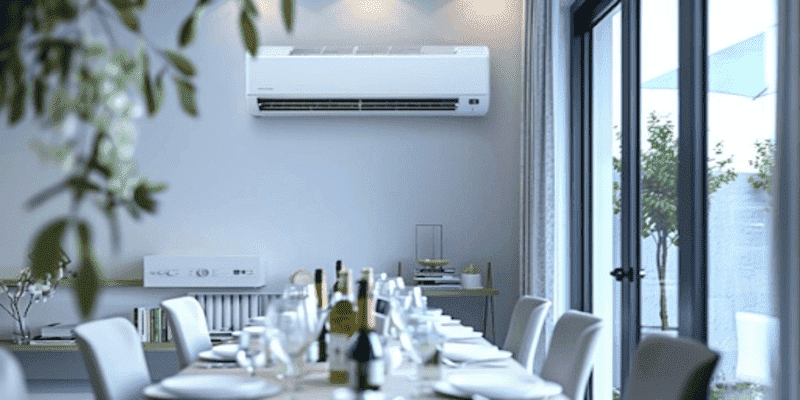How to Choose an Air Conditioner for Restaurant: The Best Choice for Your Business
Your restaurant's atmosphere directly impacts dining experiences and staff productivity. A properly sized air conditioner for a restaurant maintains optimal temperature despite kitchen heat, crowded dining areas, and changing seasons.
What can we expect from a wrong cooling system? It leads to uncomfortable guests, overworked kitchen staff, and inflated energy bills. But the right HVAC system for restaurant spaces balances performance with efficiency.
This guide examines critical selection factors including capacity requirements, system types, energy efficiency ratings, and smart features. These considerations ensure you'll find climate control that enhances your restaurant's environment while controlling operational costs.
Factors to Consider Before Buying an Air Conditioner
Your restaurant's unique characteristics dictate the perfect cooling solution. A bistro in Phoenix faces different challenges than a steakhouse in Seattle. Before exploring specific air conditioners for a restaurant options, assess these critical factors:
Space Dimensions and Layout
Square footage alone tells only part of the story. Your cooling needs depend on:
- Ceiling height (each additional foot increases cooling requirements by 15%)
- Open kitchen visibility (adds 20-30% to cooling demands)
- Window exposure and direction (western exposure can double afternoon cooling needs)
- Dining area configuration (open layouts require different airflow solutions than divided spaces)
A 2,000 square foot restaurant typically requires 60,000-80,000 BTUs of cooling capacity, but your specific layout might demand adjustments to this baseline.
Peak Occupancy Patterns
Your busiest periods create unique cooling demands:
- Human bodies generate approximately 250 BTUs per hour per person
- Friday dinner rush might require 25% more cooling than Tuesday lunch
- Seasonal tourism affects occupancy patterns and cooling needs
- Special events create temporary occupancy spikes requiring adaptive cooling
Map your typical occupancy patterns across days and seasons to identify peak cooling demands. Your HVAC system for restaurant spaces must handle these maximums while remaining efficient during slower periods.
Kitchen Proximity and Equipment Load
Restaurant kitchens generate extreme heat that affects your entire cooling strategy:
- Commercial ranges produce 25,000-30,000 BTUs hourly
- Pizza ovens can generate up to 50,000 BTUs
- Open kitchen designs allow heat to flow directly into dining areas
- Ventilation systems may not capture all kitchen-generated heat
Your air conditioner for a restaurant kitchen typically accounts for 30-40% of your total cooling requirements. Separating kitchen and dining cooling zones often provides more efficient temperature management.
Types of Air Conditioners for Restaurants
Each cooling system type offers distinct advantages for restaurant environments. Your selection impacts installation costs, operational efficiency, and maintenance requirements.
Central HVAC Systems
Restaurant HVAC central systems deliver powerful, whole-building cooling through hidden ductwork:
- Capacity ranges from 60,000-500,000+ BTUs, suitable for restaurants of all sizes
- Single system controls temperature throughout multiple zones
- Initial installation costs ($15,000-40,000) offset by longer lifespan (15-20 years)
- Requires professional maintenance quarterly to maintain efficiency
- Ductwork installation may disrupt operations in established restaurants
Central systems excel in larger establishments (2,500+ square feet) or restaurants built from the ground up where ductwork installation poses fewer challenges.
Split System Air Conditioners
Split systems offer flexible cooling without extensive ductwork:
- Indoor air handlers connect to external condensers, suitable for targeted zone cooling
- Multiple units can cool different areas independently (dining room vs. kitchen)
- Installation costs ($5,000-15,000) fall below the central systems
- 10-15 year lifespan with proper maintenance
- Visible indoor components may affect aesthetic design
Commercial air conditioner for a restaurant split systems work exceptionally well in converted spaces where adding ductwork proves impractical or prohibitively expensive.
Portable and Window Units
Portable air conditioner for restaurant use provides supplemental cooling for specific areas:
- Units deliver 8,000-14,000 BTUs, cooling spaces up to 700 square feet
- Low acquisition cost ($400-1,200) with 5-8 year lifespan
- Requires minimal installation, ideal for temporary cooling needs
- Higher operating costs and noise levels than permanent systems
- Limited aesthetic appeal for customer-facing areas
These units best serve as backup systems, temporary solutions during primary system failures, or targeted cooling for non-customer areas like offices or storage rooms.
Energy Efficiency: Reducing Operating Costs
Restaurant cooling accounts for 15-30% of your utility expenses. Selecting an energy-efficient HVAC system for restaurant use dramatically impacts your bottom line over time.
Understanding SEER Ratings
The Seasonal Energy Efficiency Ratio (SEER) measures cooling efficiency - higher numbers indicate greater efficiency. Modern commercial air conditioner for a restaurant systems offer:
- SEER 14-16: Standard efficiency, suitable for moderate climates SEER 17-19: High efficiency, reducing costs by 15-25%
- SEER 20+: Premium efficiency, cutting expenses by 25-40%
Each SEER point increase typically reduces cooling costs by 5-8%. A restaurant operating 12 hours daily can recover the premium cost of higher efficiency within 2-3 years.
Zoned Cooling Solutions
Strategic zoning prevents wasteful cooling of unoccupied spaces. Divide your restaurant into logical zones like dining areas, kitchens, and storage. This approach reduces energy consumption by 20-30% compared to whole-building cooling.
Kitchen zones benefit from dedicated cooling matched to their unique heat loads, while dining areas maintain consistent comfort without overcooling. Your air conditioner for a restaurant kitchen needs to differ significantly from patron areas.
Smart Controls and Scheduling
Programmable thermostats and smart controllers optimize operation around your business hours. Pre-cooling spaces before opening and gradually increasing temperatures during closing hours maximizes efficiency without compromising comfort.
These systems learn your restaurant's patterns, automatically adjusting to maintain ideal temperatures during service while conserving energy during off-hours.
Additional Features: Smart AC Technology and Controls
Intelligent Climate Management
Modern commercial air conditioners for restaurants feature touch-screen interfaces that replace traditional thermostats. These systems create custom temperature profiles for different service periods, automatically transitioning from prep-time to lunch service to dinner hours. Your dining establishment maintains perfect comfort without constant manual adjustments, ensuring consistent guest experiences regardless of which staff member is on duty.
Remote Access Capabilities
Remote management has transformed restaurant HVAC operation through smartphone applications that connect directly to your cooling system. Restaurant managers can verify system operation before arrival, ensuring comfortable temperatures await both staff and early customers. When unexpected schedule changes occur or when preparing for unplanned events, adjustments happen instantly from anywhere, preventing wasted energy and uncomfortable conditions.
Adaptive Performance Technology
Occupancy sensors integrated with a restaurant's air conditioner detect actual patron density throughout the space. During unexpectedly busy periods, cooling increases automatically to maintain comfort despite additional body heat. This adaptive technology ensures your cooling capacity matches current conditions rather than following rigid pre-programmed schedules, balancing guest comfort with operational efficiency.
Preventive Maintenance Systems
Internal sensors monitor system performance, detecting subtle changes that indicate potential problems before they cause failure. Your maintenance team receives specific component notifications, preventing costly emergency repairs and minimizing system downtime. This predictive approach to HVAC systems for restaurant maintenance extends the lifespan of the equipment while preventing service disruptions that could damage your reputation and revenue.
Environmental Integration
Weather-responsive operation enhances both efficiency and comfort by connecting to local weather data. On rapidly warming days, the system begins cooling earlier to prevent temperature spikes. This environmental awareness creates a consistently comfortable dining atmosphere while optimizing energy usage, particularly valuable for restaurants with outdoor seating areas or large window exposures that are susceptible to weather fluctuations.







































.jpg?height=200&name=shutterstoc%20(3).jpg)
.jpg?height=200&name=2148921409%20(1).jpg)


